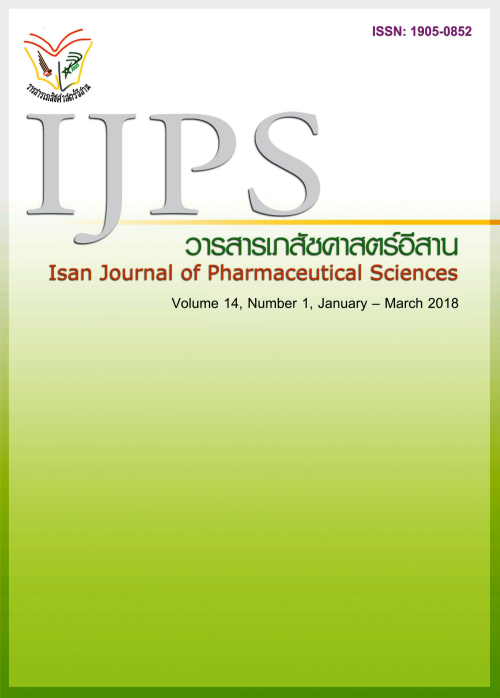Hematologic toxicities of concurrent chemoradiation in cancer patients at Ubonratchathani cancer hospital
Main Article Content
Abstract
Background: Concurrent Chemoradiation is an important strategy which is recommended in treatment many types of cancer. Hematologic toxicities from Concurrent Chemoradiation are an important drug-related problem are gradually reported. Objectives: The purpose of this study was to evaluate the prevalence of hematologic toxicities of Concurrent Chemoradiation in cancer patients at Ubonratchathani Cancer Hospital Methods: The retrospective cohort study was conducted based on medical records of 127 cancer patients who were treated with Concurrent Chemoradiation between January and June 2012 at Ubonratchathani Cancer Hospital. Incidences of hematologic toxicities including Anemia, Leucopenia, Neutropenia and Thrombocytopenia were collected were analyzed by Descriptive statistic. Hematologic toxicities incidences and hematologic laboratories before and after Concurrent Chemoradiation were compared using McNemar chi-square test and Wilcoxon signed-rank test, respectively. Results: 126 patients (99.2%) have got hematologic toxicities after Concurrent Chemoradiation. There were 21 patients (16.5%) have Grade 3-4 toxicities. Anemia was the most common toxicities. Incidences of hematologic toxicities were significant increased and hematologic laboratories were decreased after Concurrent Chemoradiation (P<0.05). Conclusions: The incidences of hematologic toxicities were significant increased after Concurrent Chemoradiation in concordant to declining hematologic laboratories.
Article Details
In the case that some parts are used by others The author must Confirm that obtaining permission to use some of the original authors. And must attach evidence That the permission has been included
References
Bartelink H, Roelofsen F, Eschwege F, Rougier P, Bosset JF, Gonzalez DG, et al. Concomitant radiotherapy and chemotherapy is superior to radiotherapy alone in the treatment of locally advanced anal cancer: results of a phase III randomized trial of the European Organization for Research and Treatment of Cancer Radiotherapy and Gastrointestinal Cooperative Groups. J Clin Oncol 1997;15:2040-9.
Bosset JF, Calais G, Mineur L, Maingon P, Radosevic-Jelic L, Daban A, et al. Chemotherapy with preoperative radiotherapy in rectal cancer. N Engl J Med 2006; 355:1114-23.
Cairncross G, Wang M, Shaw E, Jenkins R, Brachman D, Buckner J, et al. Phase III trial of chemoradiotherapy for anaplastic oligodendroglioma: long-term results of RTOG 9402. J Clin Oncol 2013;31:337-43.
Chitapanarux I, Tharavichitkul E, Kamnerdsupaphon P, Pukanhapan N, Vongtama R. Randomized phase III trial of concurrent chemoradiotherapy vs accelerated hyperfractionation radiotherapy in locally advanced head and neck cancer. J Radiat Res 2013; 1–8.
Curran WJ Jr, Paulus R, Langer CJ, Komaki R, Lee JS, Hauser S, et al. Sequential vs. concurrent chemoradiation for stage III non-small cell lung cancer: randomized phase III trial RTOG 9410. J Natl Cancer Inst. 2011;103:1452-60.
Laviano A, Meguid RA, Meguid MM. Principles of Radiation Oncology. In: DeVita VT Jr, Lawrence, TS, Rosenberg SA, editors. Cancer: Principles & Practice of Oncology. 8th ed.
Macdonald JS, Smalley SR, Benedetti J, Hundahl SA, Estes NC, Stemmermann GN, et al. Chemoradiotherapy after surgery compared with surgery alone for adenocarcinoma of the stomach or gastroesophageal junction. N Engl J Med 2001;345:725-30.
National Cancer Institute. Common Terminology Criteria for Adverse Events, Version 4.0. [online]. 2009 [Accessed 9th September 2013]. Available from http://evs.nci.nih.gov/ftp1/CTCAE/CTCAE_4.03_2010-06-14_QuickReference_5x7.pdf.
National comprehensive cancer network. NCCN clinical practice guidelines in oncology (NCCN guildlines®). 2016 [website]. Available from http://www.nccn.org
National Statistical Office. Number of deaths by leading cause of death and sex, whole kingdom : 2007-2014. [cited 2017 March 26]. Available from: http://service.nso.go.th/nso/web/statseries/statseries09.html
Niho S, Kubota K, Yoh K, Goto K, Ohmatsu H, Nihei K, et al. Clinical outcome of chemoradiation therapy in patients with limited-disease small cell lung cancer with ipsilateral pleural effusion. J Thorac Oncol 2008;3:723-7.
Peters WA 3rd, Liu PY, Barrett RJ 2nd, Stock RJ, Monk BJ, Berek JS, et al. Concurrent chemotherapy and pelvic radiation therapy compared with pelvic radiation therapy alone as adjuvant therapy after radical surgery in high-risk early-stage cancer of the cervix. J Clin Oncol 2000;18:1606-13.
Rosenberg SA. Principles of Surgical Oncology. In: DeVita VT Jr, Lawrence, TS, Rosenberg SA, editors. Cancer: Principles & Practice of Oncology. 8th ed. Philadelphia, PA: Lippincott Williams & Wilkins; 2008. P.284-306.
Seiwert TY, Salama JK, Vokes EE. The concurrent chemoradiation paradigm--general principles. Nat Clin Pract Oncol. 2007;4:86-100.
Van Hagen P, Hulshof MC, van Lanschot JJ, Steyerberg EW, van Berge Henegouwen MI, Wijnhoven BP, et al. Preoperative chemoradiotherapy for esophageal or junctional cancer. N Engl J Med 2012;366:2074-84.
Walsh TN, Noonan N, Hollywood D, Kelly A, Keeling N, Hennessy TP. A comparison of multimodal therapy and surgery for esophageal adenocarcinoma. N Engl J Med 1996 15;335:462-7.
World Health Organization. Cancer. [cited 2017 March 26]. Available from: http://www.who.int/cancer/en/
Yuenyao P, Chumworathayi B, Luanratanakorn S, Wongsena M, Soopa-atakon P, Chotanaprasit T. Hematologic toxicities of cisplatin concurrent chemoradiation in cervical cancer at Ubonrajchathani Cancer Center. Srinagarind Medical Journal 2007;22: 127-32.

